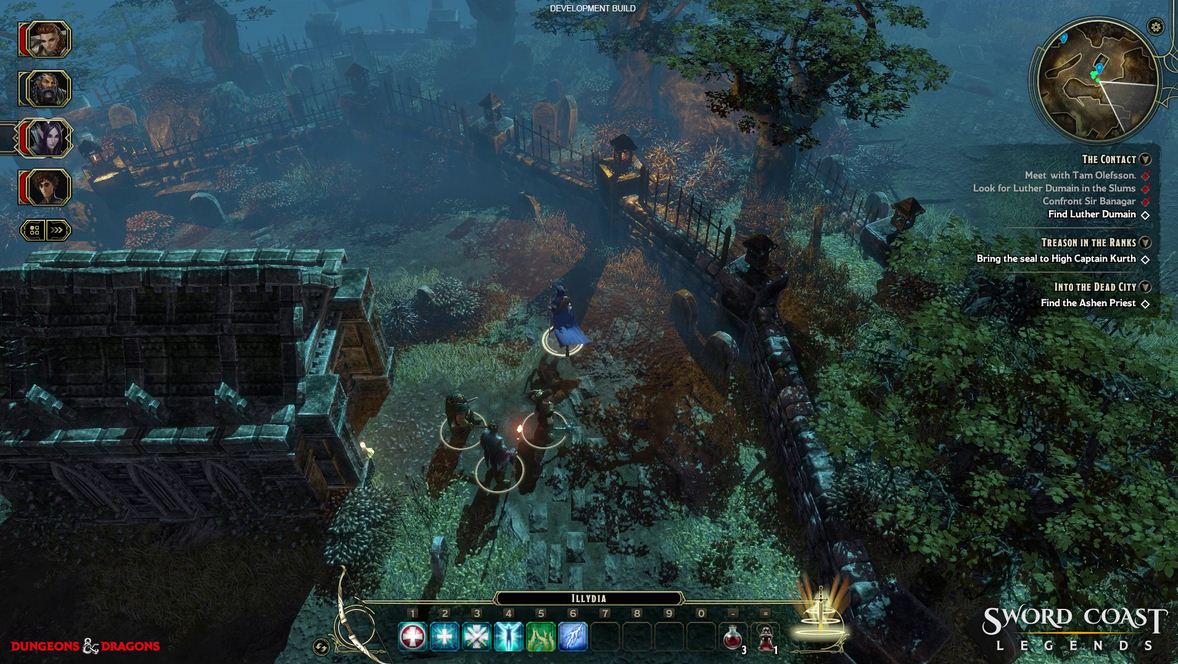That’s part of the aim of the new five-player AD&D RPG, Sword Coast Legends, according to Dan Tudge, producer and the president of developer n-space. “The DM’s there to provide a challenge for the players but he’s not there to grief the players. That said, there certainly are adversarial DMs and you definitely have the opportunity to play that way if that’s the way the party choose to play.”
The Sword Coast is that region of Forgotten Realms’ Faerûn that includes Baldur’s Gate, Luskan, Icewind Dale, Neverwinter and Waterdeep. Like the Hinterlands in Dragon Age, it’s meant to be a fertile area with a frontier feel, overrun by monsters, and has been the setting for most of the AD&D RPGs: Baldur’s Gate, Icewind Dale 1 & 2 ,D&D Online , and the many Neverwinter Nights from 1991 onwards.
A DM can do pretty much anything a DM does in a regular pen and paper game“There are iconic locations that we enjoyed visiting within those games that we want to revisit,” Tudge says. “And we’re not able to get to all of them in this first iteration, obviously, but we certainly plan to continue the adventures long after release and make sure that we visit all the areas that we’d love to go to.” What the main campaign will be, Tudge isn’t saying yet, but the focus will be on storytelling through recruitable party characters: Tudge mentions Alistair, Morrigan and Minsc as inspirations.
The game has two modes. The first is a dungeon crawl, a quick adventure with your party in a singleplayer campaign, where you control all four characters and can pause the action to give orders. The second mode is the five-player Dungeon Master campaign mode, where the DM can pre-build a campaign offline (though you will be able to start a campaign with no faffing, if you wish) and all four characters are roleplayed by your pals.
Both share the same tools, as Tudge explains. “A DM can do everything he wants within the dungeon. He can change encounters, spawn creatures, control creatures, promote creatures, demote creatures to help out the party if they’re having a bit of trouble. He can set traps, create puzzles in the dungeon. Pretty much anything and everything that a DM does in a regular pen and paper, tabletop game.” Watching a video of the Dungeon Master scattering his monsters into a battle, it looks straightforward enough to play in realtime.
In that same video, the UI and design takes more from Dragon Age: Origins, D&D Online and Neverwinter Nights than from the Infinity Engine games. That reflects a proportion of the heritage of the team: Tudge and a couple of other key developers have worked on many BioWare games (as far back as the original Baldur’s Gate in lead programmer Ross Gardner’s case), and spent three years on Dragon Age: Origins. Yet while n-space itself has been around for over 20 years, it mainly produced licensed products or DS games. Collaborator Digital Extremes has an equally limited experience of tactical RPGs. It’s an unusual party for an RPG, to say the least.
Players will be able to create their own heroes, choosing from five races human, dwarf, elf, half-elf and halfling and six classes fighter, paladin, cleric, mage, ranger and rogue. Players don’t select an alignment, however, as the team felt this unnecessary. As Tudge puts it, your choices “not just within the story but within your interactions with the other characters and the consequences of those that’s really living your true alignment.”
Wizards are no longer glass cannons, obliged to fire off a couple of spells then run awayThere are also fixes to perceived flaws in earlier games. For a start, Legends uses the most recent, 5th edition D&D ruleset, rather than the baffling earlier editions found in BioWare’s games. Tudge has been playing D&D since 1979. “For me I think fifth is the first time that they’ve really captured that original set of rules. [It’s] very reminiscent of the original AD&D and those older, earlier classic western RPGs. ”Ease of use is paramount, so THACO and its kin have been thrown down a well.
Additionally, wizards are no longer glass cannons, obliged to fire off a couple of huge spells in combat and then run a way. Now they can all use cantrips small repeatable spells like Ray of Frost alongside their traditionally overpowered spells. Combine that with the flexibility of associating weapon types with races, and you can customise classes a lot more than before.
Sword Coast Legends is being released as a full price game later this year, with DLC content to follow. Tudge and his team have a lot of history to live up to both in and out of Faerûn.








No comments:
Post a Comment